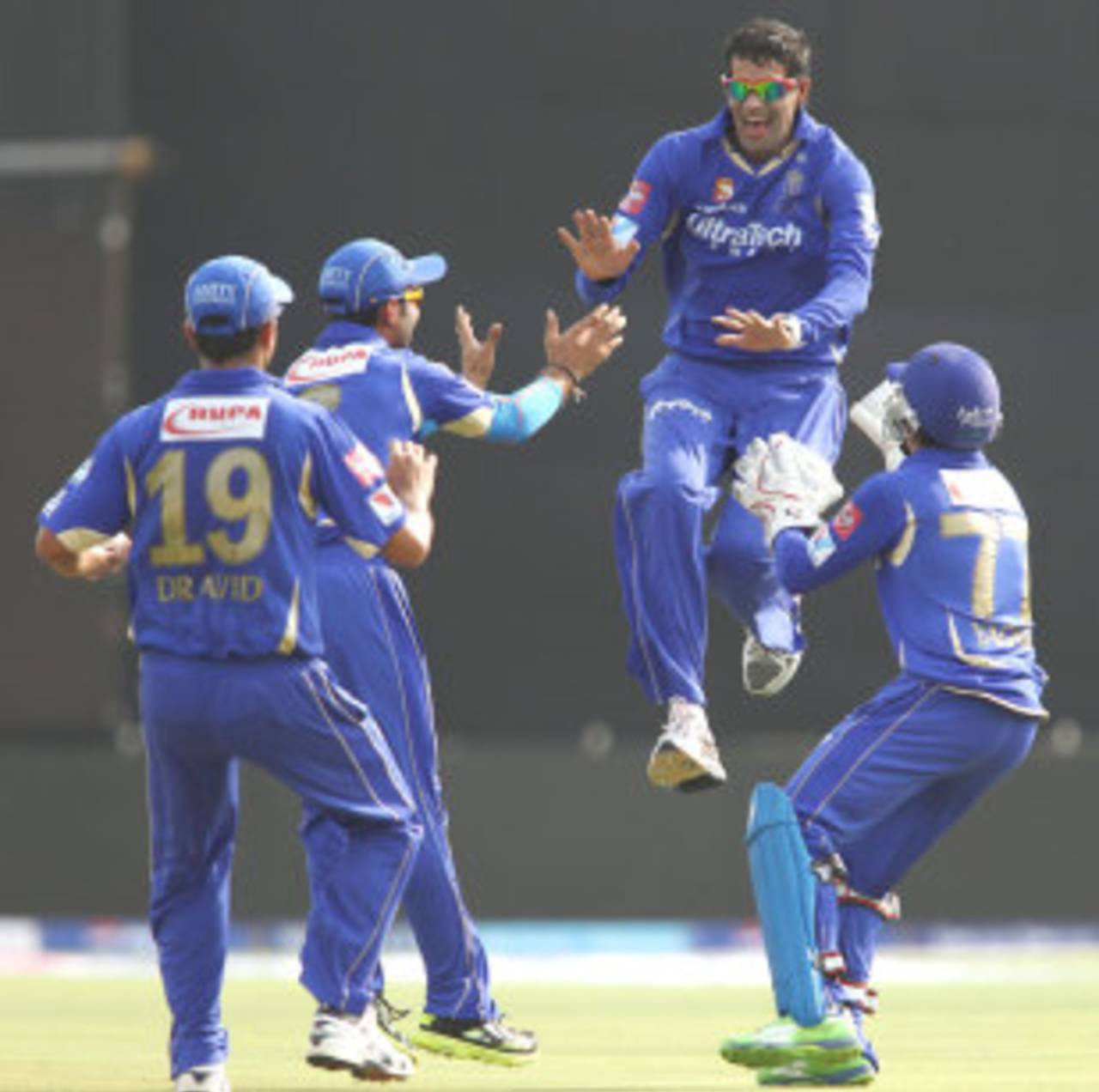The curious case of home advantage
Is the IPL creating strong city loyalties that are playing on the minds of away teams?
Harsha Bhogle
03-May-2013

Rajasthan Royals: Five wins out of five home matches so far • BCCI
As world cricket's newest laboratory, the IPL, keeps throwing up observations, it is up to those who play and who administer, and occasionally to those who watch, to come up with rational explanations.
Bowlers, for example, are making a determined comeback largely because this year's IPL has seen, by some distance, the best pitches so far. Indian fielders in their early twenties are looking significantly better than those in their late twenties, which is an indicator of the necessary importance being allotted to it in the formative years. But there is one trend that has me searching for the right reason and it might be worth a debate.
As I write this, 44 games have been played and 32 of those have been won by the home side (as opposed to 32 home wins in all of IPL 2012). I find that staggering for many reasons.
Traditionally cricket and tennis, because they are surface-centric games, have allowed for home advantage. In five-day cricket, and occasionally in ODIs, it is a huge factor. But in tournaments like the IPL, it shouldn't be that way because the conditions don't change much over 40 overs (in any case, in the IPL the differences across cities aren't as pronounced as those, say, between Kanpur and Perth). More so because each team has to have seven domestic players. And these seven aren't segregated based on where they learnt their cricket. So Sunrisers Hyderabad, who have done brilliantly at home, have four players - Shikhar Dhawan, Karan Sharma, Amit Mishra, and Ishant Sharma - from around Delhi. Mumbai Indians, who Sunrisers beat easily in Hyderabad, have as key players Pragyan Ojha and Ambati Rayudu, who learnt their cricket in Hyderabad.
Travel could be a factor. When teams play away they often have a rigorous play-pack-and-move kind of schedule. Occasionally, like one fears with Kolkata Knight Riders, they may have constructed a team for one set of conditions (low, slow in Kolkata) and find they don't have the right people for a hard, bouncy surface.
But it still isn't enough to show a 73% home-win situation. In fact the Sunrisers Hyderabad v Mumbai Indians game was an interesting one to look at. If that surface was indeed made for slow bowlers, Ojha and Harbhajan Singh should have outbowled the opposition, and Dinesh Karthik, Rohit Sharma and Rayudu should have outbatted them. It didn't happen.
I wonder if there are parallels to be drawn from football, where too home sides like to create a fortress. The surface isn't a factor there. The weather might be but that could only be really significant if you are playing in the Russian winter, for example, or playing at high altitude - in Bolivia or Mexico, say. And in any case if Chelsea are a few tube stations away from playing at Arsenal, the conditions shouldn't be a factor at all.
In the next few years the hypothesis that franchise-driven T20 cricket will be closer in its DNA to football and basketball than to traditional cricket will be tested further
The fans make the difference in football, don't they, creating a climate of hostility. Scientists are talking of enhanced testosterone levels when playing at home (apparently the postures of winning, which come from confidence, boost the production of testosterone!). Also, it seems winning at home boosts the androgen receptors in the parts of the brain responsible for motivation more than winning away does.
Maybe, just maybe, the IPL in its sixth year is evolving as a league, creating strong city loyalties (certainly Virat Kohli will have a point of view there!), and playing on the minds of away teams. It is also likely therefore that we may have to look at football and basketball rather than at traditional cricket to explain certain phenomena in T20 leagues.
Football, for example, is telling us that the quality of owner management (brought to the fore by the Blackburn Rovers episode and maybe, in another context, by what happened with Leeds United) could be as big a factor as the innate ability of the players themselves. And therefore, going ahead, this is something that IPL franchises, and specifically their owners, will have to be careful about. Certainly if player skill was the only determining factor, it cannot explain why Pune Warriors have floundered while Sunrisers Hyderabad or Rajasthan Royals have, in a relative sense, flourished.
Maybe a clearer picture will emerge by the end of May, and in the next few years the hypothesis that franchise-driven T20 cricket will be closer in its DNA to football and basketball than to traditional cricket will be tested further. These are exciting times and that is why I often refer to the IPL as a laboratory. But like with those who work in labs, we too must look at these observations with an open mind. Just as a closed mind would have denied us much of the knowledge that has come our way from science, so too will an obsession with the past prevent us from enjoying the future.
Harsha Bhogle is a commentator, television presenter and writer. He is currently contracted to the BCCI. His Twitter feed is here